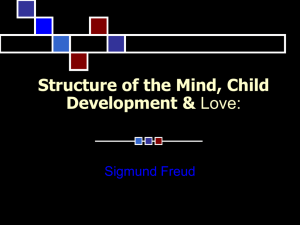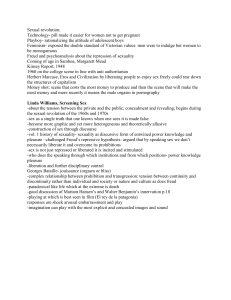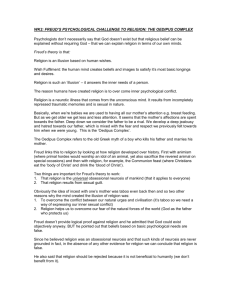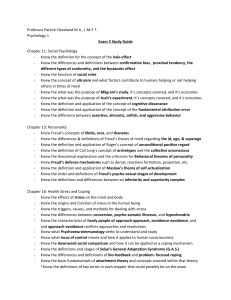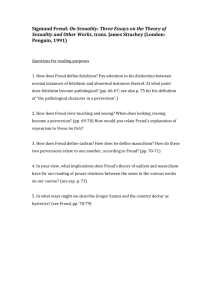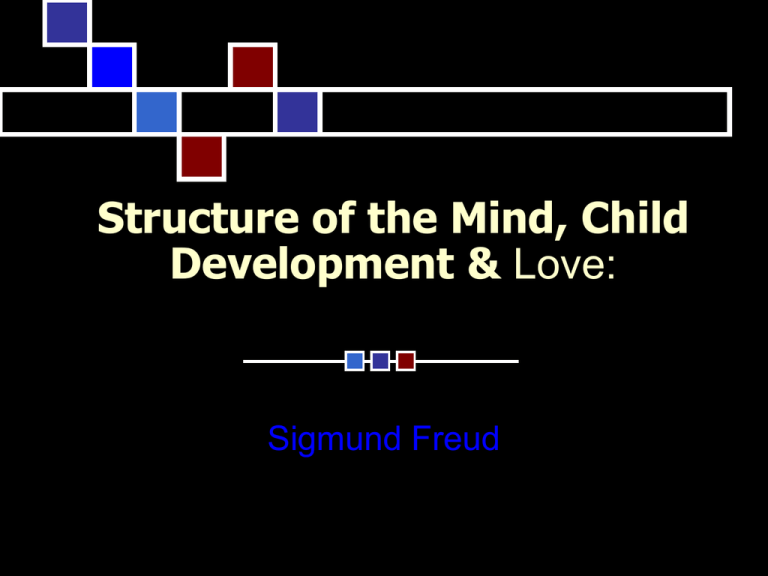
Structure of the Mind, Child
Development & Love:
Sigmund Freud
Section II: Psychoanalytic
Approaches to Self & Literature
(covered in our course)
(1)
(2)
(3)
(4)
Structure of the Mind, Child
Development & Love
Dream and Sexual Symbols
Lacan’s Views of Desire & Split Identity
Psychological Disorders
Outline
Starting Questions & Key Words
General Introduction
Freud’s Premise
1.
2.
3.
Psyche; an example
Sexuality, Love and Desire
Child Development, Repression and Sublimation
Issues and Discussion
Examples: 1) Literature and Fine Arts; 2) Dali,
3) “Eveline”
(assignment
for next week)
Starting Questions
Are we rational or autonomous? (作你自己的主
人) How is our body related to our mind –and
soul? Can the latter two transcend the former
(e.g. when it is ill)? Are they formed by it and
also in resistance to it (e.g. its desires)? Or
does the mind work ‘through’ the body (e.g.
bodily performance of the mind)?
What are Freud’s theories of human psyche (or
mind) and sexuality? Do you agree with them?
Do you have examples of the influences of id or
superego? Do you agree with Freud that babies
have sexual desires?
Starting Questions
Is intimate love definitely sexually driven?
Should our sexual desires be repressed
or liberated? What do you think about
cohabitation for college students (who
are couples)?
Have you experienced Oedipus/Electra
complex and/or castration fear?
Key Words
Sexuality, libido, pleasure principle
id, ego, superego,
Reality principle, Repression and
sublimation
child development: Erotogenic zones,
oral, anal and genital phases;
Oedipus/Electra complex, castration fear
Freudian Psychoanalysis:
General Introduction
One branch of the studies of human
psychology (the others: abnormal, social,
cognitive, biological, etc.)
(our textbook) studies of mind and
personality (e.g. Coleridge’s def. of
imagination; Nietzsche’s Apollonian and
Dionysian.
Emergence of Freudian psychoanalysis:
Freud’s Interpretation of Dreams clip
24:20 – 25:30 –27:30
Freud: Three Premises
1. Most of the individual's mental
processes are unconscious. (c: tip of an
iceberg) (text: 49)
2. All human behavior is motivated
ultimately by what we would call sexuality.
The prime psychic force is libido, or
sexual energy.
3. Because of the powerful social taboos
attached to certain sexual impulses, many
of our desires and memories are
repressed.
The Unconscious
--cannot be pointed at; can only be
"diagnosed"
--the reverse of consciousness; takes a
large part of our mind.
Making itself manifest through "gaps"-unintended lapses in memory, slips of
tongue, puns and dreams tip of an
iceberg (text 49; 50)
e.g. “Young Goodman Brown” the sea in
The Piano (and several other feminist
films)
Our Psyche: three models
More and more specific descriptions of our mind:
1. Descriptive
The conscious – perceptual or sensory
consciousness which orders reality;
the preconscious –the elements of
experience which can be called into
consciousness;
the unconscious– desires, images and ideas
unknown to and repressed by us.
2. Economic (Systematic): For self-preservation,
ego negotiates between “pleasure principle”
and “reality principle”
Our Psyche: three models (2)
(textbook pp. 149-51)
3. Dynamic: the interplay of forces within
the mind, or the tensions that develop
when instinctual drives erupt, surface
and meet the necessities of external
reality formation of the mind out of
the body and its experience of pleasure
and pain
Our Psyche: 3-Part Structure
Superego
morality p.
repository of
conscience & pride
Follows reason and
morality
circumspection
protect society
e.g. internalized
parental discipline
• Ego
•reality p
•Intermediary
• protects one’s
self
•e.g. restrain
from crying in
order to get
what it wants
Id
pleasure p.
repository of libido
Follows instinct
and passion
self-satisfaction
e.g. babies’ nonstop crying
(textbook p. 51-52)
Examples?
Example I: “No Problem (?)”
No Problem = “On Problem”
Problem (1): Desire for a female aerobic
teacher
Disguised as “exercise” Fantasies—screen
projection censored:
Example I: “No Problem”
Problems (2) Courting attempts frustrated
1) visits Natalie with a bunch of flowers –
nervous conflicting desires
2) rejected by many in “The Little Black book”
3) Zolga—lady high above on a mt. or far away
Desire for Zolga
Expressed thru’ photographic &
stereotypical images (fantasies)
Example I: “No Problem”
Problem (3): self split into three; the two
others appear whenever he acts.
Example I: “No Problem”
In between the conflicting two:
Id figure: likes to eat, is messy and sexdriven;
Superego figure: Polite, rational, cautious,
prohibiting. (e.g. To leap over the gulf or not)
Example I: “No Problem”
Images and their symbolic meanings:
water dripping down his face, rain, waterfalls,
embarrassment, obstacles, insatiable desire,
sexual difficulties;
closing door—rejection; selfcompartmentalized
Images and their symbolic
meanings:
black dog—animal desire
foods
Solution:
Dilemma: to call or not to call
Solution: after some inner struggle,
she is still there.
Solution:
Killing the two;
Integrating the three;
Closing the door against the dog.
No problem at the end?
Animal
and divided selves are
locked indoor.
The film critiques but also
centers on male ego.
Freud’s View of Sexuality and
Love (Singer 100-)
1) love as the fusion of sexuality and tenderness.
Love: Tenderness and affection directed toward the
ones who takes care of the baby;
Two currents (love and sexuality; identification and
possession) fused only in early childhood; hardly
combined in adulthood. (e.g. angel and whore as
men’s love objects)
There is always a yearning for a confluence of these
two currents. (And, for Lacan, return to the realm of
plenitude Lacan’s idea of desire as lack.)
Freud’s View of Sexuality and
Love 2 (Singer 100-)
2) Love as libidinal energy;
Libido = energy, “dynamic manifestation of
sexuality.”
Freud’s idea of Sexuality is broader than the
general conception:
It includes not just adult coital sex,
but also “the sexual life of perverted persons and
also of children.”
Perversion= sexual but not genital activities.
Children—polimorphous,
The Pervert – fixated on non-genital love objects
which “normal” people have outgrown.
Freud’s View of Sexuality
and Love 3 (Singer 100-)
3) Love as Eros
The drive or instinct of life which attaches
individuals to each other and ultimately unifies
mankind;
4) Love as the mixture of Eros and one’s aggressive
instinct (death drive).
Almost every intimate relationship between two
people which lasts for some time leaves a
sediment of feelings of aversion and hostility.
(Singer 114) Agree?
Freud’s View of Sexuality
and Love 4 (Grosz 126 -)
Two Kinds: Anaclisis (依賴心理) and Narcissism
Anaclitic love: love for the care-taker (mother or
her substitute)
Narcissistic love: those who are “seeking
themselves as a love object”
Is there a gender tendency?
For Freud: A—”an active, masculine type of love”
N—”the feminine form [involving] the passive aim
of beling loved.”
Do you agree?
Romantic Love: Freud’s View
(G 127)
The anaclitic lover:
Tends to over-evaluate the love-object (putting the
love-object on a pedestal and abjecting the self)
Anaclisis is not so much based on a valorization of
her unique charms and attributes as much as his
position as lover.
It is “derived from the child’s original narcissism
and thus corresponds to a transference of that
narcissism to the sexual object.” (Freud qtd in
Grosz 127)
He is “the subject who has what the (m)other
lacks.”
(e.g. man’s rescue fantasy; Male spectator’s
identifying with the grand female image on the
screen.)
(Female) Narcissism
Secondary and defensive reassertion of the
girl’s pre-oedipal narcissism, a compensation for
her oedipal castration.
Normal femininity (passivity) and motherhood; (takes
on the role of object of desire and mother.)
The masculinity complex (Tom boy)
A reactivated narcissism (vain, shallow, skilled in
artifice, bound up by the desire to be loved) –far more
dependent and subordinate than it seems.
Passive position of semblance and seduction.
Do you agree? Can women be narcissistic
without a man? Is narcissism a necessary state
of love? Yes for Freud. Primary
narcissism//auto-eroticism
Child development
oral stage
anal stage
latent period
phallic stage
genital stage
What is happening in this process ... is a gradual
organization of the libidinal drives . . .
Oedipus complex and gendering process
With Oedipus complex starts the process of
socialization
Textbook: p. 53-
Child development (2)
1. oral stage
(sucking)
2. anal stage
(withholding, expulsion)
3. phallic stage
(castration complex)
4. latent period
5. genital stage
Auto-eroticism
Oedipus complex
(positive and negative
constellation)
puberty
Oedipus complex
Oedipus complex in Boys
Loving Mother, Hating father
Castration fear
Positive constellation:
identifies with Father, later
loves other women
Negative constellation:
identifies with Mother and
loves Father or unable to
love other women.
Electra complex in Girls
loving Mother, hating
Father
loving Father + Penis envy
Loving Father and
identifying with Mother in
order to produce babies
(phallus) for Father.
Negative: unable to love
Father or other men.
Repression and Sublimation
Libido as flows of energy.
Once held back (as if water being
dammed up), it has to find other outlets.
Two possible outcome –
sublimation, (indirect expressions in Dream
or Art)
The return of the repressed.
“All the achievements of civilization result from
the discharge of sublimated energy.” (Singer 103)
// Civilization and its Discontents.
fixation (e.g. neurosis, perversion such as
fetishism)
Key Issues in Freud’s views of
sexuality & Oedipus complex
Recognition of Father’s authority
Development from bi-sexuality to
heterosexuality
The influence of sexuality, parents and
childhood on our personality
Are we born to be destructive and
aggressive? Is sexuality the source of
our energy?
Child development (3)
Beyond Freud
Pre-Oedipal
Symbiosis
(Identification
with Mother)
Oedipus
complex &
its
resolution
ego
psychology
Object-Relation
Theory: e.g.
Transitional Objects
such as receiving
blanket
Summary: Freud’s Major
Concepts
The Unconscious & Structure of the
psyche
the child's sexual development-a. polymorphous sexuality, three stages,
fixation
b. Oedipal stage--gendering process,
Oedipus complex, castration fear
(next time) dream analysis--condensation,
substitution, symbolization
repression and pyschological disorder:
psychological or physical abnormalities as
symptoms (or covert expressions of
desire)biography
Examples of Freud’s
Oedipus complex
Sons and Lovers –Paul not able to love
the woman who resembles his mother.
Peter Pan –as Wendy’s Other (with
phallic power)
Leonardo –his androgenous figures
Edgar Allan Poe, his rebellion against
authority and his fixation on deadly
women
“Araby” – the child in lack of maternal
love.
Example: SALVADOR DALI
His stylistic concerns: eroticize reality
+ Trompe-l'oeil
'After Freud it is the outer world, the
world of physics, which will have to
be eroticized and quantified.‘ Dali,
IN 'THE WORLD OF SALVADOR
DALI,' MACMILLAN 1962
(source: SALVADOR DALI http://www.mmlab.ktu.lt/Dali/index.html )
Example: SALVADOR DALI
"My whole ambition in the pictorial
domain is to materialize the images
of concrete irrationality with the
most imperialist fury of precision."
"to systematize confusion and
contribute to the total discrediting of
the world of reality" (source)
Example: SALVADOR DALI
His Life
Gala and Dali met in the summer of 1929. In that year,
Dali's paintings were full of flourishing sexual symbols.
"This historic meeting was accompanied by a fit of
extreme madness. Dali was in such a state of constant
exaltation that every time he started to speak to Gala
he burst into insane laughter" (Neret, 22).
“The Great Masturbator” bears witness to Dali's
first encounter with Gala and the state in which she left
him-midway between 'hard' and 'soft'" (Neret, 28).
The Great Masturbator
"The Great Masturbator" is one of Dali's
classic surreal images of sexual
persecution and an obsession with
castration, impotence, and masturbation.
It is also an image that plays off of
psychic automatism and Freudian dream
logic: displacement, condensation, and
fetish. (source)
Where do we see displacement,
condensation and fetish?
Language of Dream
Fetish: A tremendous nose -leaning on the ground
A large, soft, terrorized
head, livid and waxlike, with
pink cheeks; the closed
eyes (embellished by very
long eyelashes) suggest the
state of sleeping or
dreaming.
Condensation:Metamorphosis
at the neck region
The mouth, replaced by a decaying
grasshopper crawling with ants.
Example 2: “Eveline”
Structure: 1. How does the story start and end?
Point of View: Is the third-person narrator critical of
or sympathetic with Eveline? Or neither?
Character: How is Eveline related to her father and
mother? What is her environment like (home and
the “Stores” where she works)? Why can’t she
elope with Frank? What is he associated with?
Recurring images in The Dubliners: death,
disintegration of community, degradation of religion,
liquor, constraint to the degree of paralysis. Do you
see them in this story?
How do we do a psychoanalytic reading of this story?
“Eveline”: Structure and Point of
View
Structure:
In medias res
Repetition: E leans by the window at the beginning;
holds on to the railing at the end.
Narrative Perspective and Narrative time:
Third-person, sympathetic perspective following the
flow of Eveline’s thinking (from present to past, both
pros and cons). (Not yet stream-of-consciousness)
Narrative time: longer on the home scene than the
harbor scene;
More thinking at home (3.5 pages) self-enclosure
and paralysis (0.5 page)
Eveline vs. her Father & Mother
Father
Occasionally kind (first
page—not bad); read her
out a ghost story and made
toast for her at the fire,
made the kids laugh
Used violence first on the
boys and then on Eveline
Squabble for money
Mother
--dead
--her promise to the mother
to keep her home together;
Her mother’s death by
exhaustion or craziness
an Italian organ-player
playing the same song and
her mother's final, "foolish"
repeated phrase, "Derevaun
Seraun“ (A slurred Gaelic
phrase meaning either "the end
of pleasure is pain" or the end
of song is raving madness“)
Eveline in a world of Decay and
Constraint -- Images
Death – of people, Dust (cretonne), evening
Decay – (of religion) the priest gone,
Change – good old past, field built with
houses (with bright bricks, shining roofs vs.
their brown houses)
Constraint – window, people’s comments,
father’s control
Hard life and work
“Eveline”: Images of Virginal
Constraint
Blessed Margaret Mary Alacoque
Saint Mary Alacoque made a vow of chastity at the
age of four although she later admitted that at this
age she did not understand what either a vow or
chastity was. At the age of eight her father died and
she was sent to a convent school, where her piety
so impressed the nuns that she was allowed to
make her first Communion (領聖餐) one year later.
From ages eleven to fifteen she suffered from
rheumatism and paralysis. She also inflicted bizarre
punishments upon herself once carving the name
Jesus on her breast with a penknife.
“Eveline”: No Escape
Frank –ambiguous:
–represent the remote, the open and free, and
“romantic” (Buenos Aires, opera Bohemian
girl, tales of remote countries, sea and going
places)
-- suggestions of his not being serious: Buenos
Aires, night boat
Eveline does not want to be like her mother,
but either staying or leaving, she ends up
being like her mother.
“Eveline”: Psychoanalytic Reading
Eveline, like Hamlet, suffers from oedipal
neurosis: forever loving her father and
taking her mother’s role to take care of
him. a trapped animal
Symptoms:
Psychological: circular and regressive
thinking about childhood. as if the whole
world tumbles onto her.
Physical: paleness, nausea and inactivity.
Eveline in Context
Dubliners: setting—Dublin, Ireland in and
around 1901 –(after the 1845 famine)
impoverished, less populated, with some
passionate cultural revival movements, but still
dominated by religion.
Religious Division: The privileged classes in
Dublin were nonnative British Protestants;
Catholicism: the traditional religion of the vast
majority of the Irish--became associated with
grassroots Irish cultural and political identity.
A woman used to represent the state of
paralysis in Dublin. (Araby: Woman symbolizing
lost ideal)
References
Psychoanalytic Criticism: A Reappraisal
by Elizabeth Wright. Polity,1998.
Nature of Love, Vol. 2: Courtly &
Romantic. Irving Singer. University of
Chicago Press, 1998.
Salvador Dali 1904-1989
by Gilles Neret, Giles Neret 20th
Century Art History Tutorials:
http://www.csulb.edu/~karenk/index.html
Assignment
Reader: chap 3 to p. 55; chap 4: pp.
146-61
"The Blind Man" by D. H. Lawrence

